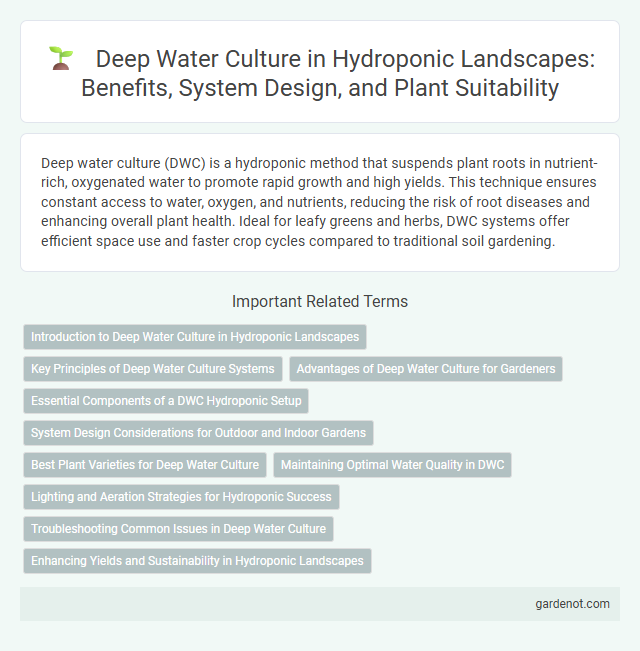Deep water culture (DWC) is a hydroponic method that suspends plant roots in nutrient-rich, oxygenated water to promote rapid growth and high yields. This technique ensures constant access to water, oxygen, and nutrients, reducing the risk of root diseases and enhancing overall plant health. Ideal for leafy greens and herbs, DWC systems offer efficient space use and faster crop cycles compared to traditional soil gardening.
Introduction to Deep Water Culture in Hydroponic Landscapes
Deep Water Culture (DWC) is a hydroponic technique where plant roots are suspended in oxygenated nutrient-rich water, promoting rapid growth and higher yields. In hydroponic landscapes, DWC systems enable efficient nutrient uptake and consistent hydration, making them ideal for leafy greens and herbs. This method reduces soil dependency, minimizes pest risks, and enhances space utilization within controlled environments.
Key Principles of Deep Water Culture Systems
Deep Water Culture (DWC) systems rely on suspending plant roots directly in oxygenated nutrient-rich water to maximize nutrient uptake and growth rates. Maintaining optimal dissolved oxygen levels above 6 mg/L is critical to prevent root suffocation and promote healthy root development. Effective air stone aeration combined with nutrient solution monitoring ensures consistent pH and electrical conductivity (EC) within the ideal range of 5.5-6.5 and 1.2-2.0 mS/cm respectively.
Advantages of Deep Water Culture for Gardeners
Deep Water Culture (DWC) offers gardeners superior oxygenation and nutrient absorption by suspending plant roots directly in oxygen-rich, nutrient-infused water. This method accelerates plant growth rates and enhances overall crop yields compared to traditional soil gardening. DWC systems also reduce water usage and minimize risks of soil-borne diseases, promoting healthier and more sustainable plant development.
Essential Components of a DWC Hydroponic Setup
A Deep Water Culture (DWC) hydroponic setup relies on essential components such as an oxygen-rich nutrient solution, net pots to support plant roots, and an air pump with an air stone to maintain proper oxygenation. The nutrient reservoir must be airtight to prevent contamination, while maintaining optimal pH levels between 5.5 and 6.5 for maximal nutrient absorption. Durable materials like food-grade plastic and reliable oxygenation systems are critical for healthy root development and high-yield growth in hydroponic landscapes.
System Design Considerations for Outdoor and Indoor Gardens
Deep Water Culture (DWC) systems require precise oxygenation and nutrient management to optimize plant growth in both outdoor and indoor hydroponic gardens. Outdoor DWC setups must consider environmental factors like temperature fluctuations, sunlight exposure, and potential water contamination, necessitating durable materials and UV-resistant reservoirs. Indoor DWC designs focus on controlled temperature, artificial lighting, and compact water circulation systems to maintain optimal dissolved oxygen levels and nutrient balance for root health.
Best Plant Varieties for Deep Water Culture
Leafy greens such as lettuce, spinach, and kale thrive in Deep Water Culture systems due to their fast growth and nutrient absorption capabilities. Herbs like basil, mint, and cilantro also perform exceptionally well, benefiting from the constant oxygenated water supply. Fruiting plants such as tomatoes and peppers require careful nutrient management but can yield high-quality produce in DWC setups.
Maintaining Optimal Water Quality in DWC
Maintaining optimal water quality in Deep Water Culture (DWC) systems is critical for maximizing plant growth and nutrient uptake. Key parameters such as pH levels, dissolved oxygen, temperature, and nutrient concentration must be continuously monitored and adjusted to ensure a stable growing environment. Regular water changes, aeration through air stones or diffusers, and the use of high-quality nutrient solutions prevent harmful pathogen build-up and oxygen depletion, promoting healthy root development and reducing crop failure risks.
Lighting and Aeration Strategies for Hydroponic Success
Deep water culture (DWC) requires precise lighting and aeration strategies to maximize plant growth and yield in hydroponic landscapes. Implementing full-spectrum LED lighting ensures optimal photosynthesis, while continuously oxygenating the nutrient solution with air stones prevents root hypoxia. Maintaining an ideal balance of light intensity and dissolved oxygen levels directly enhances nutrient uptake and overall plant health in DWC systems.
Troubleshooting Common Issues in Deep Water Culture
Deep Water Culture (DWC) hydroponic systems often face challenges such as root rot, nutrient imbalances, and oxygen deficiency. Monitoring pH levels between 5.5 and 6.5 and maintaining dissolved oxygen above 6 mg/L are critical to preventing root diseases and ensuring optimal nutrient uptake. Regularly checking water temperature, ideally between 18-22degC, and using air stones or diffusers can mitigate oxygen stress and promote healthy plant growth.
Enhancing Yields and Sustainability in Hydroponic Landscapes
Deep Water Culture (DWC) systems enhance hydroponic landscape yields by providing plants with continuous access to oxygenated nutrient-rich water, promoting faster growth and higher productivity compared to soil-based methods. This technique optimizes root health and nutrient uptake, significantly reducing water usage and minimizing environmental impact for sustainable agriculture. Integration of renewable energy sources and automated monitoring in DWC further boosts efficiency and scalability in commercial hydroponic landscaping.
Deep water culture Infographic

 gardenot.com
gardenot.com